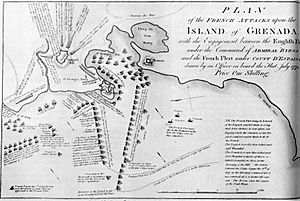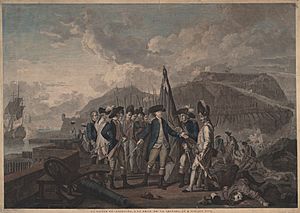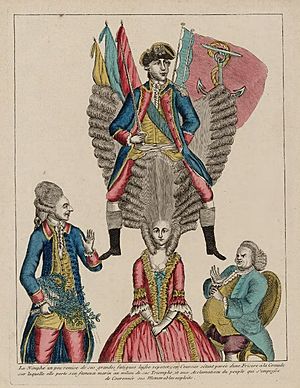Capture of Grenada (1779) facts for kids
Quick facts for kids Capture of Grenada |
|||||||
|---|---|---|---|---|---|---|---|
| Part of the American Revolutionary War | |||||||
 View of the French assault on the island of Grenada, 4 July 1779. Prise de l'île de la Grenade, 4 juillet 1779 by Jean-François Hue |
|||||||
|
|||||||
| Belligerents | |||||||
| Commanders and leaders | |||||||
|
Comte D'Estaing Arthur Dillon |
Lord Macartney (POW) | ||||||
| Strength | |||||||
| 2,100 men 25 ships of the line |
125 regulars 436 militia and volunteers |
||||||
| Casualties and losses | |||||||
| 114 killed 200 wounded |
about 700 prisoners 118 artillery pieces 200 merchantmen |
||||||
The Capture of Grenada was an important event during the American Revolutionary War in July 1779. It was a battle where French forces attacked and took control of the island of Grenada from the British.
The French, led by Comte D'Estaing, landed on Grenada on July 2nd. They launched their main attack on the night of July 3rd to 4th. The French soldiers bravely stormed Hospital Hill, which was a strong British fort overlooking the capital city, Saint George's.
After a fierce fight, the French captured the British cannons. They then turned these cannons against Fort George, another British stronghold. Seeing that the situation was hopeless, the British Governor, Lord Macartney, decided to surrender.
However, Admiral d'Estaing refused Macartney's surrender terms. He demanded much harsher conditions. Macartney rejected these and chose to surrender without any conditions. This meant the French could do as they pleased. D'Estaing allowed his troops to loot the town. Macartney was then sent to France as a prisoner of war.
Soon after, on July 5th, the French forces got back on their ships. They heard that a British fleet, led by Admiral John Byron, was coming. The two fleets fought a big sea battle the next day. The French damaged several British ships, but both fleets managed to return to their bases. Later, after the war ended, Grenada was given back to British control. This was part of the Treaty of Paris in 1783.
Contents
Why Was Grenada Important?
When France joined the American War of Independence in 1778, it became an ally of America. French Admiral d'Estaing arrived in the West Indies with a large fleet. Around the same time, a British fleet also arrived.
The British managed to capture St. Lucia from the French. They used St. Lucia to keep an eye on the French fleet based in Martinique. In 1779, the British fleet got even stronger. Admiral John Byron took command of their ships in the Leeward Islands.
Byron left St. Lucia in June 1779 to protect British merchant ships. This gave Admiral d'Estaing a chance to act. D'Estaing and the French governor of Martinique decided to attack nearby British islands. Their first target was Saint Vincent, which they captured on June 18th.
D'Estaing then wanted to capture Barbados, a very important British island. But the strong winds made it too hard to sail there. So, he changed his plan and decided to attack Grenada instead.
How Britain Defended Grenada
Grenada was one of Britain's wealthiest colonies. It produced a lot of sugar on its plantations. Governor Lord Macartney knew a French attack might happen. He asked Admiral Byron for help many times. However, he was told that Saint Vincent was the main concern for the French. Byron did promise to send help if Grenada was attacked.
Macartney had about 101 regular soldiers and 24 artillery men. He also had over 400 local militia and volunteers. But he wasn't sure he could trust all of them. About a third of these local forces were of French background.
The governor ordered strong forts to be built on Hospital Hill. This hill overlooked St. George's, the capital. The steep sides of the hill were protected by stone walls. The hilltop itself had a wooden fence, called a palisade, and trenches for defense.
The French Capture Grenada
The French fleet arrived off Grenada, just north of St. George's, on July 2nd. Admiral d'Estaing landed about 2,100 soldiers that day. These troops included the Irish Dillon Regiment and soldiers from other French regiments.
When the French arrived, Governor Macartney ordered his forces to retreat behind the Hospital Hill forts. D'Estaing spent July 3rd studying the British defenses. He was worried that Admiral Byron's fleet might show up at any moment. So, he decided to attack Hospital Hill quickly.
First, d'Estaing sent a message to Macartney, demanding he surrender. The British governor refused.
The Attack Plan
D'Estaing's plan was to attack the back of the forts with three columns of soldiers. They would use bayonets, which are knives attached to rifles. A smaller fourth group would create a distraction from the front. This would make the British think the main attack was coming from there.
On the evening of July 3rd, the French soldiers moved into position. Each of the three main attack columns had 300 men. They were led by Arthur Dillon, Édouard Dillon, and the comte de Noailles. The distraction force had 200 men.
At 4:00 am on July 4th, the distraction force started firing. At the same time, the other three columns charged up Hospital Hill. The British defenders were surprised and panicked. Most of them ran down the hill to the safety of Fort George.
British Surrender
In their hurry to escape, the British forgot to disable some of their cannons. They also left behind many valuable items they had brought to the hill for safety. The French quickly used the captured cannons to fire at Fort George.
Realizing that the situation was hopeless, Macartney raised the white flag, meaning surrender. The French took about 700 British prisoners. The French reported 36 killed and 71 wounded. However, British reports claimed the French had closer to 300 casualties. The French also captured 200 merchant ships in the harbor.
Admiral d'Estaing refused Macartney's suggested surrender terms. Instead, he offered his own very strict terms. Macartney found d'Estaing's terms "humiliating" and unfair. His council agreed, and the British chose to surrender unconditionally instead.
Because of this, d'Estaing allowed his troops to loot St. George's. Many of Macartney's personal belongings, including his silver, clothes, and papers, were taken or destroyed. Macartney and other important Grenadians were not allowed to go free on parole. They were sent to France as prisoners of war.
What Happened Next
Admiral Byron learned about the capture of Saint Vincent on July 1st. He was sailing to retake it when he heard about the attack on Grenada. He immediately changed course and arrived there on the morning of July 6th.
D'Estaing knew Byron was coming. He loaded most of his troops back onto his ships and sailed away at 4:00 am on July 6th. The two fleets then fought a sea battle off Grenada. D'Estaing won against Byron's disorganized attack.
There were no more major battles in the West Indies for a while. D'Estaing then sailed north and led an unsuccessful siege of British-held Savannah, Georgia in September.
D'Estaing's success in capturing Grenada and defeating Byron made him very popular in France. A play was even written about his victory.
During their time in control, the French started building new forts on Richmond Hill. These forts were designed to defend against attacks from the land, not the sea. The British finished these defenses after 1783.
Both Grenada and Saint Vincent remained under French control until the war ended. They were returned to Britain as part of the 1783 Treaty of Paris. The French governor of Grenada was reported to be harsh. After the British took control again, they were strict with the French-speaking population. This led to unhappiness and many French Grenadians moving to Trinidad. These differences in Grenadian society later led to a rebellion in 1795–96.
Images for kids








